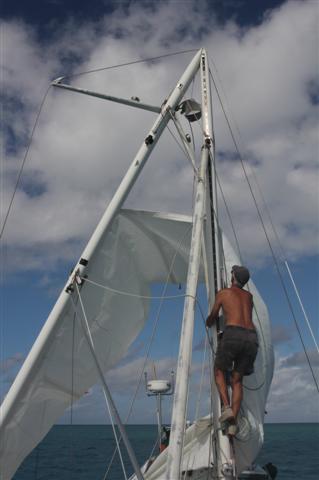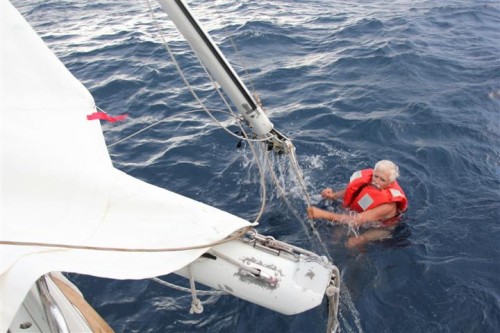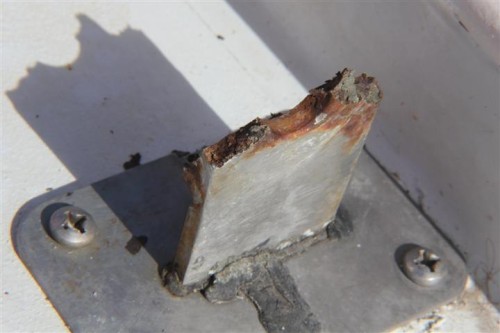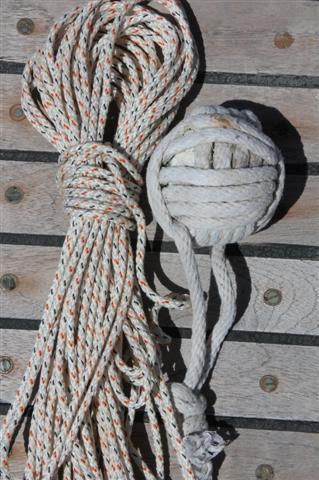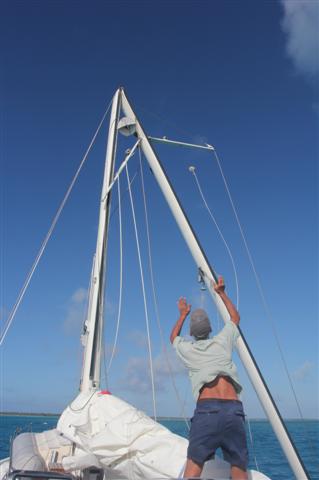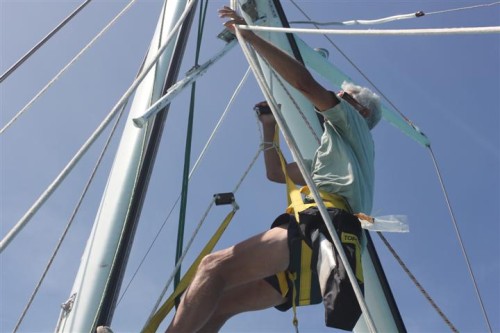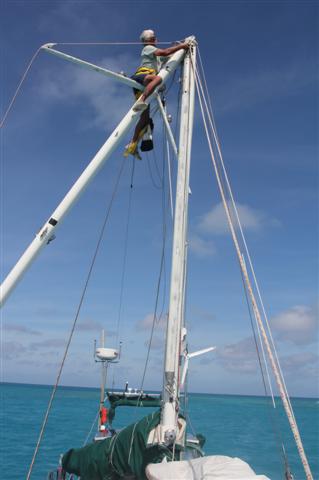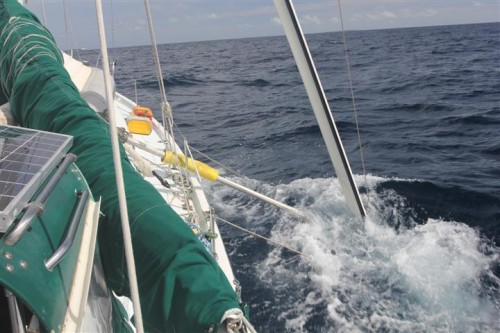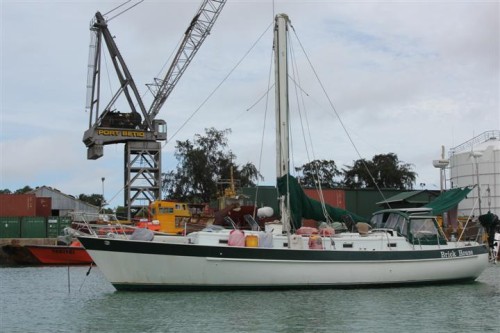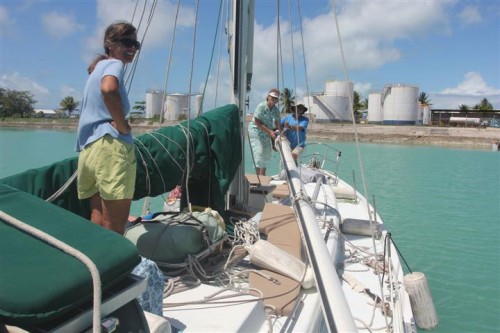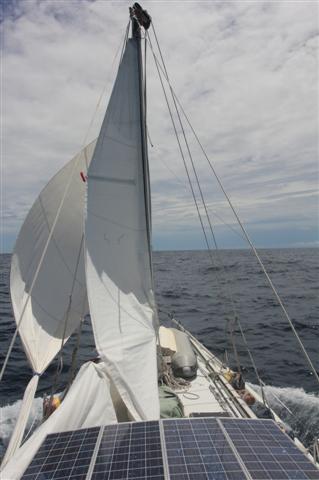This is an article which appears in the March 2018 issue of Ocean Voyager magazine. Ocean Voyager is a special, annual, publication of Ocean Navigator. But what you read below is the full, unedited version.

Cruising for over three years in the tropics of South East Asia has wilted our sea-legs. We have experienced nothing more adventurous than an occasional sudden thunder shower as we ghosted the coast of Borneo and all the shores of Thailand, Cambodia, Malaysia, Brunei and Indonesia. Now it is time to get back to serious passage making and prepare to zig zag our way cross the Indian Ocean, from Malaysia to South Africa via Madagascar and many remote islands in between. Thousand mile long passages and longer abound. Once again, we will be in belts of strong weather. In the Indian, yachting facilities are few. The boat must be in solid, long haul condition. When we depart Malaysia, we will be ready for real sailing yet the preparations have been a year in the fixing.
Heavy Weight Supplies
Owning ones own long range cruising boat is the only way to access some of the most remote specks of land in the world like in the Pacific, Holmes Reef, Minerva Reef, Bikini, Suwarrow, Fatu Hiva. Now, heading out to the Indian Ocean, we cannot miss the chance to visit the fabled Chagos, where no one lives but the largest coconut crabs and seabirds on tropical islands with countless fish on the clear reefs. Departing Malaysia, our water and fuel tanks will be full, including all our deck stowed jerry jugs. Since there will be no cheaper fuel on our horizon, some of the 5 gallon jerry jugs are one time use disposables. The waterline of Brick House will be further depressed by months of food stores. Food throughout the Indian Ocean is expensive so we are stocking up in Malaysia. As we move south in latitude and into known windy areas, our load of supplies will lighten so we will become more buoyant, agile and seaworthy. As we work our way to Madagascar, where aggressive storms are a near certainty, we want to be as unencumbered and nimble as possible; to lift and move on top of the waves, not be washed over and beaten by them. At that point, we want on our boat no more than 50 gallons of water and no more than 40 gallons of diesel in the main tanks with the remaining deck stored jerry-jugs to be empty.
General Preparation
We have worked hard removing the hatches and portlights, resealing them to stop present leaks and to insure there will be no new leaks. Cracks in the side decks were ground out and repaired. The not so clear plastic of the dodger windows was renewed. A new mainsail cover is now in place. All the rigging has been inspected. The hull has been cleaned with new antifouling applied. These are all parts of the maintenance treadmill any cruising boat owner must endure. But to successfully sail us across the Indian Ocean, we decided to order a new genoa.
 Genoa Sail
Genoa Sail
To move us through the calm weather latitudes to Sri Lanka then southward to Chagos, we have on board a new 125% genoa from Mack Sails, www.macksails.com , located half way around the world from us in Stuart, Florida. We have personally visited some of the lofts in S.E. Asia and have concluded, it is better to buy American. Our new genoa is made of 7.77oz Challenge Marblehead Dacron. “These fabrics are the finest most tightly woven fabrics in the world and rely on the quality of yarn and weave, rather than impregnated resins, to maintain integrity.” To distribute loading more evenly across the fabric on our genoa, and to hold the sail shape for 15 to 20 years, Mack sews their jibs with the more difficult miter panels rather than the easier to sew, long, crosscut panels. As we work into the stronger wind areas, we will replace the new 125% with our 90% jib made of 8.77 oz Marblehead. These sails, along with our tough little cutter sail, made by Mack, gives us the versatility needed for working through known soft and strong wind latitudes.
 Anchoring
Anchoring
After the sails, our thoughts turned to anchoring. 10 years ago a 60 lb CQR was our primary anchor till it showed how it could plow a long farmers furrow and still not dig in. That anchor nearly ended our voyage soon after it began. The 30kilo Bruce became our primary anchor which has served us well in all sorts of anchoring conditions for the past 10 years. But the Bruce was not infallible. We want to keep up on the latest anchor technology so we felt an anchor with a more pointed entry would burry quicker and could hold as securely as the Bruce normally would and possibly better. We decided to replace the Bruce with a 27 kg (60 pound) Manson Supreme anchor which is made in New Zealand. Because of their sailing environment dipping into latitudes of the roaring forties, New Zealanders know how to manufacture their yachting products to withstand harsh conditions. I don’t want to risk having gear on our boat made in China. So far, the Manson Supreme is performing as flawlessly as we had expected.
 Foul Weather Gear
Foul Weather Gear
In the tropics, when a heavy downpour or sea spray breaks over our boat, to stay dry, we have been slipping into a cheap plastic raincoat bought at a hardware store. Our “ocean” designated foul weather gear has always leaked right through the “breathable” fabric. Now we have gotten serious about foul weather gear which will do what it is advertised to do. Our research brought us to the Henri Lloyd Freedom line of foul weather gear, made of Polyamide coated with polyurethane. I recently tested this gear on a yacht delivery from Rhode Island to St. Maarten and it was impressive. It kept me warm and dry and it was not cumbersome to put on or take off. There are plenty of pockets in the right places without overdoing it. An interesting highlight is the hood which gives full wind and spray protection and can do this without ruining peripheral vision. The hood has a clear Optivision hi-vis hood system. No more messing around now, we have the good stuff. Here is Patrick’s Jacket.
 Paper Charts and Real Books
Paper Charts and Real Books
At our navigation station we have a Raymarine es128 chartplotter with a 12 inch screen. Not only does the large screen have the advantage of being viewable all the way back to the helm, the large screen gives us a much better spatial awareness than any of the smaller screens that preceded it. But there is nothing like having a large scale paper chart to see where a boat has been and where it is going. The distances in the Indian are so great, we ordered a paper chart, from Bluewater Books and Charts in Fort Lauderdale, Florida, which covers all of the Indian Ocean. That chart will be folded flat and live under the Plexiglas of the chart table. We will be able to quickly plot the location of fellow cruisers and keep track of our own wanderings. Additionally, as we start the second half of our circumnavigation, we find, despite the digital plethora of information, a printed paper cruising guide is still our preferred way to organize routes and anchorages ahead. Bluewater Books and Charts has been in business for more than 30 years, and offer the single greatest selection of paper and electronic charts, cruising guides, marine books and publications, software, flags and instruments available for sailors like us. We stocked up with the Indian Ocean Cruising Guide, theEast Africa Pilot Guide, the South Atlantic Circuit, and the Patagonia and Tierra Del Fuego Nautical Guide. Rebecca has also made .kap files(Google earth charts) for every possible stop along the way. We can now go into anchorages with full satellite images. But, at our fingertips will be all the paper books, and information we need, in one central location, without having to turn on a computer.
 Weather Information
Weather Information
Getting accurate, economical weather routing reports and communicating with those back home while we are far away from land has always been a challenge. On previous ocean crossings, we relied on our SSB radio and Pactor modem for email and weather. Sadly to say, that trusty equipment is becoming equal to using a cassette player when an IPod is available. Although there is still a use for the SSB radio for communicating on a schedule with other cruisers, its other functions are waning. We have signed up for an “Iridium GO!” Marine Package with PredictWind www.predictwind.com . Iridium Go! is a new generation Iridium satellite wifi hotspot to which all our handheld devices can connect to. PredictWind also offers a myriad of downloadable weather products, including weather routing, with intuitive, feature rich software to retrieve and examine the reports it offers. But better than using this application via a cantankerous SSB, the Iridium GO!, with an external antenna, offers the best value and least complications for downloading weather and email while on a passage, anywhere in the world. It’s not faster than SSB\Pactor but it is available around the clock, when we want it. The Iridium GO! is so completely integrated with the PredictWind software, that one would almost think they were using the application on the internet, albeit more slowly. PredictWind controls all of the connections to the GO! We will be able to receive and send emails as well, as well as utilizing 150 minutes of voice time per month, to be used through our smartphones, for family issues back home, ordering of parts or technical support at sea, or emergencies. We paired this system with another product called Xgate to add more functionality when using our laptops, through both the GO!, and when connected to the internet through other means. With such interoperability and so many advantages, an entire article could be written about the combination. Month to month contracts for service, if purchased through www.
.com , allows shutdown to a minimally priced plan while in port. Predictwind sells through Amazon too, but buying directly from Predictwind is the best way to go…get your SIM cards, external antenna, Iridium GO, weather service, through this one supplier for the best in support and service!
Another great feature of the GO! is the SOS button. This is not a substitute for a stand alone EPIRB, but a great additional tool. Geos Safety Solutions (http://www.geossafetysolutions.com ) provides free coordination of efforts in case of an emergency, as well as affordable (Search And Rescue) and Medevac if the SOS button is pressed during an emergency.
 EPIRB Batteries
EPIRB Batteries
Recently, we hand carried our ACR brand self deploying 406 GPS, EPIRB (Emergency Position Indicating Radio Beacon) and smaller PLB (Personal Locator Beacon) EPIRB on airplanes from Malaysia back to the U.S.. With the batteries in the equipment, we ran into no concerns by airport inspectors. The batteries have a long shelf life even after their 6 year expiration date but we want to take no chances. In the U.S., we sent the equipment to ACR in Ft. Lauderdale. After changing the batteries, they were mailed to us at our departure address in the U.S. so we could hand carry them back to Malaysia. Monthly, we flip the switch half way on our ACR, EPIRB, to activate the self test mode to be sure it is successfully acquiring satellites and transmitting to the test receiving station properly.More ACR Epirbs
 Propspeed
Propspeed
I have never been able to keep antifouling on any propeller that was installed on Brick House no matter what material the prop was made of. Antifouling far too soon disappeared which meant the beginning again of the biweekly chore to scrub the marine growth from the prop and drive shaft. In the 85 degree tropical water of which we are accustomed, the work was not terribly challenging. However, there are frigid waters in our future of which even layers of wetsuits are no enticement for me to go in for a casual prop cleaning. Cruising friends who have used Propspeed, which is a silicone coating, are very satisfied. The application is a very precise process of sanding, cleaning, etching, primer application then the final application of the clear silicone coating. The clear coating is not antifouling but an ultra smooth surface which marine organisms have a very difficult time attaching to. If organisms do settle, they are easily brushed off. The manufacturer of our Kiwiprop suggest it is not necessary to prime the Zytel blades before applying traditional antifouling or Propspeed. Following those directions, I have never had success with antifouling staying on the Zytel blades for an adequate amount of time. Applying to the Zytel, I followed the Propspeed directions in the same steps as the stainless steel components were treated except for the etching. With a Kiwiprop however, an applicator must be careful not to build up any material in the area of swing of the trailing edge of the blades which could inhibit their forward to reverse function. Propspeed is another great product made in New Zealand. There are imitators but only Oceanmax, makes Propspeed and has a long positive track record.
Nonskid Decks
A major safety item is the disappearance of the nonskid on our side decks. Since painted 9 years ago, our decks have gotten slippery over the years from the wearing away of the sand non-skid imbedded in the deck paint. Where we are going, is not a place for unsure footing. There are 3 grades of non-skid sand, fine, medium and coarse. We used the coarse and applied it to the wet two part paint using a plastic peanut butter jar with a lot of holes drilled in the lid, like a large salt shaker. The large grain is a good gripper like we need but can be a little uncomfortable when kneeling down with bare knees. Cosmetically, I think the medium grain would be nicer and may not retain discoloration and dirt like the coarse does.
Jack Lines
We haven’t seen our yellow jack lines in years. They and the inflatable PFDs have been stuffed somewhere in the back of a hanging locker. This will be the time to dig them out. In our normal mode of cruising, jack lines and harnesses can be a dangerous encumbrance which restricts ones movements on deck and becomes an annoying leg tripper. Normally, we just don’t need them and since entering the Pacific, I don’t recall seeing any cruising friends using them. There comes a time though, in very rough weather, when waves are breaking over the boat and the deck is pitched more like the steep slope of a glacier that it would be ridiculous not to strap into a safety tether and be shackled to the boat, especially if one had to go forward on deck.
 Titanium Bow Roller
Titanium Bow Roller
Years ago we changed all our stainless steel chain plates to grade 5 titanium. The price of titanium parts is slowly falling so we decided this would be the time to replace the 41 year old stainless steel bow roller/chain plate assembly with one made of titanium. We removed the existing assembly and sent it to Allied Titanium, now located in Sequim, Washington www.alliedtitanium.com . Grade 5 titanium weighs a little more than half of 316 stainless steel yet is 3.5 times stronger. It is not affected by salt water or electrolysis. Since we will be keeping Brick House for a very long time, titanium upgrades and the safety margin it brings us make it a good investment.
 SONAR
SONAR
While hauled out of the water to paint the bottom in Malaysia, I installed a new faring block and sonar transducer. This is a new addition to our array of Raymarine, navigational electronics. We now have on our big MFD (multi function display), a sonar that gives a color rendition of what is below our keel down to 900 feet whether it is rocks or alive and swimming. There is another mode called DownVision which uses a sweep of frequencies rather than the standard 200kz or 50 kz.. This gives far greater detail and definition to the targets. With this viewing equipment, we can see what the textures and contours the ocean floor below us is made of. This is especially useful when feeling our way into remote anchorages and knowing if we make a mistake, we will be on rocks or soft mud, and once we are anchored, how many and how big the fish are outside our cockpit.
 Solar Panel
Solar Panel
Soon we will be away from marinas…we will need to be energy conscious and our alternative energy sources need to be at their best. We took apart our KISS wind generator, and put in new thermostats, and bearings, and rebalanced the blades. It now runs better than it ever has. We also ultimately determined, with help from the “Solar Queen”, Amy, a sailor herself, from altE (http://www.altestore.com), that our 25+ year old solar panels were truly at the end of their life. Her team recommended the Morningstar ProStar MPPT-25 solar controller, along with one new 265 watt solar panel to replace our 4 small 51 watt panels, in the same footprint, on top of our hard dodger. Prior to this installation, we were seeing about 20-30 amp hours per sunny day. Now we are easily seeing 60-70. The team at altE is passionate about solar power, and are able to provide astounding results.
 For all the work we have just completed on Brick House, we should do just fine getting to Durban, S. Africa and on around to Cape Town, where we begin again on the revolving list of maintenance and repairs.
For all the work we have just completed on Brick House, we should do just fine getting to Durban, S. Africa and on around to Cape Town, where we begin again on the revolving list of maintenance and repairs.

For more information or to order, click on any link below.






Nearly a year now , and ZERO growth!
As an Amazon Associate I earn from qualifying purchases
https://whereisbrickhouse.com/2019/04/09/communication-evolution-on-brick-house-iridium-go-predictwind/




